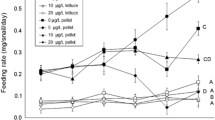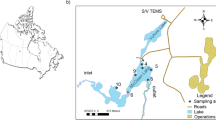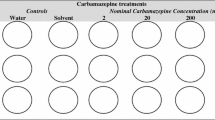Abstract
Selenium effects in nature are mediated by the relatively large bioconcentration of aqueous Se by primary producers and smaller, yet critical, dietary transfers to primary consumers. These basal processes are then propagated through food webs to higher trophic levels. Here we quantified the movement of dissolved Se (as selenite) to periphyton, and used the resultant periphyton as a food source for conducting full life-cycle dietary Se exposures to the mayfly Centroptilum triangulifer. Periphyton bioconcentrated Se ~2,200-fold from solution in a log-linear fashion over dissolved Se concentrations ranging from 1.1 to 23.1 μg L−1. We examined the influence of two feeding ration levels (1x and 2x) on trophic transfer, tissue Se concentrations, maternal transfer, and functional endpoints of mayfly performance. Mayflies fed a lesser ration (1x) displayed greater trophic transfer factors (mean TTF, 2.8 ± 0.4) than mayflies fed 2x rations (mean TTF, 1.1 ± 0.3). In 1x exposures, mayflies exhibited significant (p < 0.05) reductions in survivorship and total body mass at dietary [Se] ≥ 11.9 μg g−1, reduced total fecundity at ≥4.2 μg g−1, and delayed development at ≥27.2 μg g−1. Mayflies fed a greater ration (2x) displayed reduced tissue Se concentrations (apparently via growth dilution) relative to 1x mayflies, with no significant effects on performance. These results suggest that the influence of Se on mayfly performance in nature may be tied to food resource availability and quality. Furthermore, nutritional status is an important consideration when applying laboratory derived estimates of toxicity to risk assessments for wild populations.





Similar content being viewed by others
References
Andrahennadi R, Wayland M, Pickering IJ (2007) Speciation of selenium in stream insects using x-ray absorption spectroscopy. Environ Sci Technol 41(22):7683–7687
ASTM (1980) Standard practice for conducting acute toxicity test with fishes, macroinvertebrates and amphibians. E-790-80. Philadelphia
Baines SB, Fisher NS (2001) Interspecific differences in the bioconcentration of selenite by phytoplankton and their ecological implications. Mar Ecol Prog Ser 213:1–12
Besser JM, Canfield TJ, Lapoint TW (1993) Bioaccumulation of organic and inorganic selenium in a laboratory food-chain. Environ Toxicol Chem 12(1):57–72
Casey R (2005) Results of aquatic studies in the McLeod and Upper Smokey River systems. http://environmentgovabca/info/library/7743pdf. Accessed 2 Feb 2011
Chandini T (1989) Survival, growth and reproduction of Daphnia carinata (Crustacea, Cladocera) exposed to chronic cadmium stress at different food (Chlorella) levels. Environ Pollut 60(1–2):29–45
Clifford HF, Boerger H (1974) Fecundity of mayflies (Ephemeroptera), with special reference to mayflies of a brown-water stream of Alberta, Canada. Can Entomol 106(10):1111–1119
Conley JM, Funk DH, Buchwalter DB (2009) Selenium bioaccumulation and maternal transfer in the mayfly Centroptilum triangulifer in a life-cycle, periphyton-biofilm trophic assay. Environ Sci Technol 43(20):7952–7957
Creighton N, Twining J (2010) Bioaccumulation from food and water of cadmium, selenium and zinc in an estuarine fish, Ambassis jacksoniensis. Mar Pollut Bull 60(10):1815–1821
Debruyn AMH, Chapman PM (2007) Selenium toxicity to invertebrates: Will proposed thresholds for toxicity to fish and birds also protect their prey? Environ Sci Technol 41(5):1766–1770
DeForest DK, Brix KV, Adams WJ (1999) Critical review of proposed residue-based selenium toxicity thresholds for freshwater fish. Hum Ecol Risk Assess 5(6):1187–1228
Enserink EL, Kerkhofs MJJ, Baltus CAM, Koeman JH (1995) Influence of food quantity and lead-exposure on maturation in Daphnia magna—evidence for a trade-off mechanisms. Funct Ecol 9(2):175–185
Fan TWM, Teh SJ, Hinton DE, Higashi RM (2002) Selenium biotransformations into proteinaceous forms by food web organisms of selenium-laden drainage waters in California. Aquat Toxicol 57:65–84
Fuller RL, Roelofs JL, Fry TJ (1986) The importance of algae to stream invertebrates. J N Am Benthol Soc 5:290–296
Hamilton SJ (2004) Review of selenium toxicity in the aquatic food chain. Sci Total Environ 326(1–3):1–31
Hamilton SJ, Buhl KJ (2004) Selenium in water, sediment, plants, invertebrates, and fish in the Blackfoot river drainage. Water Air Soil Pollut 159(1–4):2–34
Heinz GH, Sanderson CJ (1990) Avoidance of selenium-treated food by mallards. Environ Toxicol Chem 9:1155–1158
Heugens EHW, Tokkie LTB, Kraak MHS, Hendriks AJ, van Straalen NM, Admiraal W (2006) Population growth of Daphnia magna under multiple stress conditions: joint effects of temperature, food, and cadmium. Environ Toxicol Chem 25(5):1399–1407
Holmstrup M, Bindesbol AM, Oostingh GJ, Duschl A, Scheil V, Kohler HR, Loureiro S, Soares A, Ferreira ALG, Kienle C, Gerhardt A, Laskowski R, Kramarz PE, Bayley M, Svendsen C, Spurgeon DJ (2010) Interactions between effects of environmental chemicals and natural stressors: a review. Sci Total Environ 408(18):3746–3762
Hopkins WA, Snodgrass JW, Roe JH, Staub BP, Jackson BP, Congdon JD (2002) Effects of food ration on survival and sublethal responses of lake chubsuckers (Erimyzon sucetta) exposed to coal combustion wastes. Aquat Toxicol 57(3):191–202
Hopkins WA, Staub BP, Snodgrass JW, Taylor BE, DeBiase AE, Roe JH, Jackson BP, Congdon JD (2004) Responses of benthic fish exposed to contaminants in outdoor microcosms—examining the ecological relevance of previous laboratory toxicity tests. Aquat Toxicol 68(1):1–12
Hopkins WA, DuRant SE, Staub BP, Rowe CL, Jackson BP (2006) Reproduction, embryonic development, and maternal transfer of contaminants in the amphibian Gastrophryne carolinensis. Environ Health Perspect 114(5):661–666
Janz DM, DeForest DK, Brooks ML, Chapman PM, Gilron G, Hoff D, Hopkins W, McIntyre DO, Mebane CA, Palace VP, Skorupa JP, Wayland M (2010) Selenium toxicity to aquatic organisms. In: Chapman PM, Adams WJ, Brooks ML et al (eds) Ecological assessment of selenium in the aquatic environment. SETAC Press, Boca Raton, pp 141–231
Jensen PD, Rivas MD, Trumble JT (2005) Developmental responses of a terrestrial insect detritivore, Megaselia scalaris (Loew) to four selenium species. Ecotoxicology 14(3):313–322
Karimi R, Chen CY, Pickhardt PC, Fisher NS, Folt CL (2007) Stoichiometric controls of mercury dilution by growth. Proc Natl Acad Sci USA 104(18):7477–7482
Karimi R, Fisher NS, Folt CL (2010) Multielement stoichiometry in aquatic invertebrates: when growth dilution matters. Am Nat 176(6):699–709
Lamberti GA (1996) The role of periphyton in benthic food webs. In: Stevenson RJ, Bothwell ML, Lowe RL (eds) Algal ecology: freshwater benthic ecosystems. Academic Press, San Diego, pp 533–572
Laskowski R, Bednarska AJ, Kramarz PE, Loureiro S, Scheil V, Kudlek J, Holmstrup M (2010) Interactions between toxic chemicals and natural environmental factors—a meta-analysis and case studies. Sci Total Environ 408(18):3763–3774
Lemly AD (1993) Guidelines for evaluating selenium data from aquatic monitoring and assessment studies. Environ Monit Assess 28(1):83–100
Lemly AD (2009) Aquatic hazard of selenium pollution from mountaintop removal coal mining. White paper submitted for Senate hearing. http://wvgazette.com/static/lemley2009.pdf. Accessed 4 Dec 2010
Lemly DA, Skorupa JP (2007) Technical issues affecting the implementation of U.S. Environmental Protection Agency’s proposed fish tissue-based aquatic criterion for selenium. Integr Environ Assess Manag 3(4):552–558
Liess M, Champeau O, Riddle M, Schulz R, Duquesne S (2001) Combined effects of ultraviolet-B radiation and food shortage on the sensitivity of the Antarctic amphipod Paramoera walkeri to copper. Environ Toxicol Chem 20(9):2088–2092
Luoma SN, Presser TS (2009) Emerging opportunities in management of selenium contamination. Environ Sci Technol 43(22):8483–8487
Luoma SN, Rainbow PS (2005) Why is metal bioaccumulation so variable? Biodynamics as a unifying concept. Environ Sci Technol 39(7):1921–1931
Luoma SN, Johns C, Fisher NS, Steinberg NA, Oremland RS, Reinfelder JR (1992) Determination of selenium bioavailability to a benthic bivalve from particulate and solute pathways. Environ Sci Technol 26(3):485–491
Maher W, Roach A, Doblin M, Fan T, Foster S, Garrett R, Moller G, Oram L, Wallschläger D (2010) Environmental sources, speciation, and partitioning of selenium. In: Chapman PM, Adams WJ, Brooks ML et al (eds) Ecological assessment of selenium in the aquatic environment. SETAC Press, Boca Raton, pp 47–92
McDunnough J (1931) New species of North American Ephemeroptera. Can Entomol 63:82–93
Muscatello JR, Janz DM (2009) Selenium accumulation in aquatic biota downstream of a uranium mining and milling operation. Sci Total Environ 407(4):1318–1325
Muscatello JR, Belknap AM, Janz DM (2008) Accumulation of selenium in aquatic systems downstream of a uranium mining operation in northern Saskatchewan, Canada. Environ Pollut 156(2):387–393
Ohlendorf HM (2003) Ecotoxicology of selenium. In: Hoffman DJ, Rattner BA, Burton GA Jr, Cairns J Jr (eds) Handbook of ecotoxicology, 2nd edn. Lewis Publishers, Boca Raton, pp 465–500
Orr PL, Guiguer KR, Russel CK (2006) Food chain transfer of selenium in lentic and lotic habitats of a western Canadian watershed. Ecotoxicol Environ Saf 63(2):175–188
Peckarsky BL, Cowan CA, Penton MA, Anderson C (1993) Sublethal consequences of stream-dwelling predatory stoneflies on mayfly growth and fecundity. Ecology 74(6):1836–1846
Pieters BJ, Paschke A, Reynaldi S, Kraak MHS, Admiraal W, Liess M (2005) Influence of food limitation on the effects of fenvalerate pulse exposure on the life history and population growth rate of Daphnia magna. Environ Toxicol Chem 24(9):2254–2259
Pond GJ, Passmore ME, Borsuk FA, Reynolds L, Rose CJ (2008) Downstream effects of mountaintop coal mining: comparing biological conditions using family- and genus-level macroinvertebrate bioassessment tools. J N Am Benthol Soc 27(3):717–737
Presser TS, Luoma SN (2009) Modeling of selenium for the San Diego Creek Watershed and Newport Bay, California, Open-File Report 2009-1114. US Department of the Interior
Riedel GF, Ferrier DP, Sanders JG (1991) Uptake of selenium by fresh-water phytoplankton. Water Air Soil Pollut 57–58:23–30
Schlekat CE, Purkerson DG, Luoma SN (2004) Modeling selenium bioaccumulation through arthropod food webs in San Francisco Bay, California, USA. Environ Toxicol Chem 23(12):3003–3010
Simmons DBD, Wallschläger D (2011) Release of reduced inorganic selenium species into waters by the green fresh water algae Chlorella vulgaris. Environ Sci Technol 45(6):2165–2171
Standley LJ, Sweeney BW, Funk DH (1994) Maternal transfer of chlordane and its metabolites to the eggs of a stream mayfly Centroptilum triangulifer. Environ Sci Technol 28(12):2105–2111
Stanley TR, Smith GJ, Hoffman DJ, Heinz GH, Rosscoe R (1996) Effects of boron and selenium on mallard reproduction and duckling growth and survival. Environ Toxicol Chem 15(7):1124–1132
Stewart R, Grosell M, Buchwalter D, Fisher N, Luoma S, Mathews T, Orr P, Wang W (2010) Bioaccumulation and trophic transfer of selenium. In: Chapman PM, Adams WJ, Brooks ML et al (eds) Ecological assessment of selenium in the aquatic environment. SETAC Press, Boca Raton, pp 93–139
Sweeney BW, Vannote RL (1984) Influence of food quality and temperature on life-history characteristics of the parthenogenetic mayfly, Cloeon triangulifer. Freshw Biol 14(6):621–630
Sweeney BW, Funk DH, Standley LJ (1993) Use of the stream mayfly Cloeon triangulifer as a bioassay organism—life-history response and body burden following exposure to technical chlordane. Environ Toxicol Chem 12(1):115–125
Swift M (2002) Stream ecosystem response to, and recovery from, experimental exposure to selenium. J Aquat Ecosyst Stress Recovery 9(3):159–184
Tabak LM, Gibbs E (1991) Effects of aluminum, calcium and low pH on egg hatching and nymphal survival of Cloeon triangulifer McDunnough (Ephemeroptera, Baetidae). Hydrobiologia 218(2):157–166
USEPA (2004) Draft aquatic life water quality criteria for selenium – 2004. http://www.epa.gov/seleniumcriteria/pdfs/complete.pdf. Accessed 2 Feb 2011
Van Campenhout K, Bervoets L, Blust R (2007) Assimilation efficiencies of Cd and Zn in the common carp (Cyprinus carpio): effects of metal concentration, temperature and prey type. Environ Pollut 145(3):905–914
Vannote RL, Sweeney BW (1980) Geographic analysis of thermal equilibria—a conceptual model for evaluating the effect of natural and modified thermal regimes on aquatic insect communities. Am Nat 115(5):667–695
Wang WX, Fisher NS (1999) Delineating metal accumulation pathways for marine invertebrates. Sci Total Environ 238:459–472
Wang WX, Fisher NS, Luoma SN (1995) Assimilation of trace elements ingested by the mussel Mytilus edulis: effects of algal food abundance. Mar Ecol Prog Ser 129(1–3):165–176
Wayland M, Crosley R (2006) Selenium and other trace elements in aquatic insects in coal mine-affected streams in the Rocky Mountains of Alberta, Canada. Arch Environ Contam Toxicol 50(4):511–522
Williams DA (1972) Comparison of several dose levels with a zero dose control. Biometrics 28(2):519–531
Xie L, Flippin JL, Deighton N, Funk DH, Dickey DA, Buchwalter DB (2009) Mercury(II) bioaccumulation and antioxidant physiology in four aquatic insects. Environ Sci Technol 43(3):934–940
Xie LT, Funk DH, Buchwalter DB (2010) Trophic transfer of Cd from natural periphyton to the grazing mayfly Centroptilum triangulifer in a life cycle test. Environ Pollut 158(1):272–277
Acknowledgments
We would like to thank Tom Augspurger (USFWS), Gerald LeBlanc (NCSU), Monica Poteat (NCSU), Joseph Skorupa (USFWS), and two anonymous reviewers for their feedback on earlier drafts of this manuscript. Funding for this research was provided by the College of Agriculture and Life Sciences at North Carolina State University and the US Environmental Protection Agency (83425501-0).
Author information
Authors and Affiliations
Corresponding author
Rights and permissions
About this article
Cite this article
Conley, J.M., Funk, D.H., Cariello, N.J. et al. Food rationing affects dietary selenium bioaccumulation and life cycle performance in the mayfly Centroptilum triangulifer . Ecotoxicology 20, 1840–1851 (2011). https://doi.org/10.1007/s10646-011-0722-1
Accepted:
Published:
Issue Date:
DOI: https://doi.org/10.1007/s10646-011-0722-1




